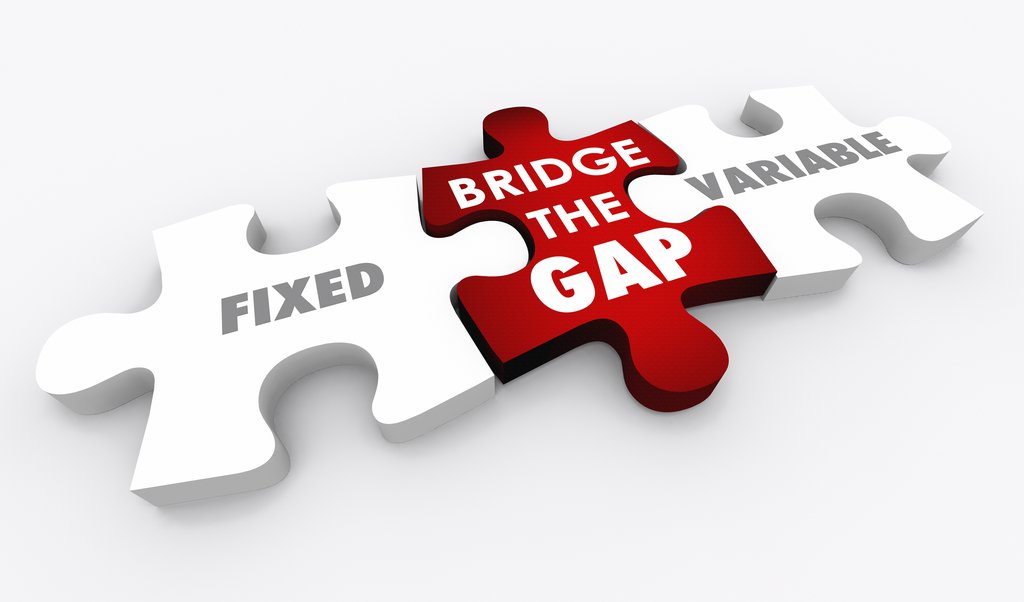Fixed Rate Mortgage vs Variable Rate Mortgage vs Adjustable Rate Mortgage. Which Mortgage is Right For Me?

Is A Fixed Rate Mortgage Better Than A Variable Rate Mortgage or an Adjustable Rate Mortgage?
When it comes to deciding what kind of mortgage you should take, whether it is a variable rate or fixed rate mortgage, it's important to know the difference between the two since you are likely talking about a significant amount of money, and are likely committing to a mortgage that will take you many years to pay off.
When it comes to determining which one is a better choice for you, variable rate vs fixed rate, that really depends on your risk tolerance and your personal financial goals and belief system. It's important to know the full difference between them and the risks and benefits associated with each one.
What's the difference between a variable rate mortgage and an adjustable rate mortgage?
When it comes to what is commonly referred to as a "variable rate mortgage" it's critical to understand that there are two very different types of mortgage products available where the mortgage interest rate can vary, and the way that affects the monthly payments and actual amortization are different from one another also. The two different types of "variable rate" mortgages are the Adjustable Rate Mortgage also known as ARM, and the true Variable Rate Mortgage also known as VRM.
What is an Adjustable Rate Mortgage?
The first type or mortgage that is referred to as a "variable" mortgage is called the Adjustable Rate Mortgage (ARM). With an adjustable rate mortgage your monthly payments will fluctuate as the interest rate does.
What are some of the benefits of an Adjustable Rate Mortgage?
One of the key benefits of an adjustable rate mortgage (ARM) is that if the rates on your mortgage decrease, so will your payments.
A second benefit is that for the most part, you can convert an adjustable rate mortgage into a fixed rate mortgage in order to lock in the interest rate at the time on conversion.
Another benefit with an ARM is that no matter what happens to the interest rate, your amortization will never grow, provided that you continue to make all of your monthly mortgage payments on time.
One more big benefit is that if you decide to prepay your mortgage early, you will most likely only be charged 3 months worth of interest as a prepayment penalty with most mortgage lenders. This can vary slightly from lender to lender, but for the most part, this is what the majority of lenders use to calculate the prepayment penalties on ARM mortgages as of the date that this article was written.
With an ARM, if the interest rate of your mortgage decreases during the term, you can save money and get reduced payments. This can help increase your cashflow at the end of the month.
What are some of the potential risks associated with an Adjustable Rate Mortgage?
One of the main risks of an Adjustable Rate Mortgage where your mortgage payments are tied in with the rate, is that over time your payments might fluctuate up or down. If the rates grow significantly, so too will your monthly payments. As a result you might encounter potential financial difficulties down the road. However, as perviously mentioned, to help mitigate this, you do have the option with a adjustable rate mortgage to close it at a fixed rate in the future, although at that point the rate may have already grown to a point that makes the monthly payments uncomfortable for you to maintain.
What is a Variable Rate Mortgage?
The second type of mortgage commonly referred to as a "variable mortgage", is actually a true Variable Rate Mortgage (VRM). In this type of mortgage your mortgage rate is a variable rate, but your monthly mortgage payment remains fixed at a specific amount. This means that your monthly payments will remain the same regardless of whether or not the variable interest rate increases or decreases.
What are some of the benefits of a Variable Rate Mortgage?
Unlike the adjustable rate mortgage, one of the key benefits of a variable rate mortgage (VRM) is that you can more easily continue to budget your monthly expenses including a fixed mortgage payment, since your payment will likely never change even if the mortgage rate increases.
Another key benefit, similar to the ARM, is that you can choose to close in a fixed rate at anytime with most lenders. This way, moving forward your rate cannot change.
With a true Variable Rate Mortgage if the interest rates decrease, and stay lower for long enough, then your overall amortization period can be reduced meaning that you may be able to pay off your mortgage sooner.
One benefit of a variable rate mortgage, similar to an adjustable rate mortgage, is that should you choose to break your mortgage term early and repay your mortgage for whatever reasons, commonly due to selling your property, you will only owe 3 months of interest payments as a penalty for most lenders. It is important to keep in mind that some lenders may specify more than 3 months in their mortgage commitment, that is why it is vital that you thoroughly review your mortgage commitment with your mortgage broker before signing it.
In the event that you still have a good amount of time remaining on your mortgage term and you wish to pay off the mortgage early, then this 3 months of interest payments may be significantly less than some prepayment penalties associated with many fixed rate mortgages. This is because the prepayment clause on most fixed rate mortgages states that the prepayment penalty will be calculated based on the greater of 3 months of interest payments or interest rate differential, provided that you still have quite some time remaining on your mortgage term.
What are some of the potential risks associated with a Variable Rate mortgage?
In the event that your mortgage interest rate increases during the term of your mortgage, you are at risk of having a negative amortization at the time of refinancing, renewal, or once your initial amortization period is reached. What I mean by that is, let's say you take out a mortgage with a 30 year amortization with a variable interest rate and fixed monthly payment amount. If your monthly payment remains fixed, but the variable rate increases, then after 30 years, you would not have paid off your entire mortgage and would still owe money to the lender. This is assuming you are in the same mortgage for the entire amortization period. This can cost you a lot more in the end.
If you choose to refinance your mortgage at any point before the amortization period ends, the concern with this would then be that you could theoretically owe more money than when you took out the mortgage originally. This can occur within the first year or 5 years, depending on when, and by how much, the rates go up if they do.
What are the benefits of a Fixed Rate Mortgage?
In the case of a fixed rate mortgage, both your payments and rate remain fixed. Given the ultra low rates today, this may be a more attractive option for someone looking to get a great low mortgage rate and maintaining a stable monthly payment while ensuring that they keep paying down the principal of their mortgage loan and building up equity in their property.
What are the potential risks of a Fixed Rate Mortgage?
Some of the potential risks associated with a fixed mortgage are as follows:
- If the mortgage rates decrease, you will still be paying the higher rate and missing out on potential savings.
- If you choose to payout the mortgage prior to the end of your term, the prepayment penalty can be much higher than if you were to opt for a variable rate mortgage. This is because with a fixed rate mortgage, the prepayment clause usually states that you will be charged the greater of either 3 months of interest or interest rate differential. When it comes to calculating the interest rate differential for the remainder of your term, this can get quite expensive.
What's the potential downside to paying the interest rate differential penalty?
In order to fully understand the possible severity of the interest rate differential penalty (IRD), it's important to know how a bank or lender might calculate the IRD at any given point of your mortgage contract term.
Here's when lender will most likely use the IRD calculation:
- If your mortgage is a fixed rate mortgage and 3 months of interest is less than the interest rate differential amount;
- if your mortgage has a higher interest rate than the current mortgage rate the lender is offering; and
- if you signed up for your current mortgage within the last 5 years.
How is the Interest Rate Differential calculated?
The actual IRD amount and how it's calculated could be dependent on the interest rate stated on your current mortgage commitment.
Mortgage lenders tend to advertise interest rates that are available to them at the time. These advertised rates are called posted interest rates, or simply "Posted Rates". The interest on your specific mortgage agreement may be lower than the lender's advertised posted rate, higher, or the same depending on how they qualify your application. If the mortgage interest rate that you are given is lower than the posted interest rate, then you received what is referred to as a discounted rate.
When it comes to breaking out of a fixed mortgage term and it's time for the lender to calculate the interest rate differential penalty, lenders will typically use 2 interest rates in their calculation of the IRD. They would first calculate all interest payments that are remaining to be made for the duration of the term using your current rate or the posted rate at the time you originally signed your mortgage commitment.
The lender would then calculate a second amount by using either the current posted rate for a similar length mortgage, or the current posted rate less for a similar length mortgage term the discount you were originally offered. They would multiply that interest payment out over the remaining amount of months left on your current term.
The difference between these two amounts would be the IRD amount that you would need to pay, if it is greater than the amount that 3 months of interest payments would equate to.
When calculating the Interest Rate Differential (IRD), the lender most commonly uses 2 interest rates. First, they would calculate the entire interest fees that are remaining to be paid on your current term. They calculate the entire interest fees left to pay on your current term for both rates. The difference between these amounts is the IRD.
Example Calculation of Interest Rate Differential vs 3 Months of Interest Penalties
To break this down for you, here's an example using the following hypothetical assumptions:
- An outstanding mortgage balance of $500,000
- A contract interest rate of 1.79% taken out 2 years ago
- 36 months remaining on a 5-year term mortgage
- Initial amortization rate of 30 years
- Current posted rate for a 36 month mortgage term offered by your lender is 1.29%
The two types of penalties would be approximately:
- 3 months of interest-only penalty would be approximately: $2,109.90
- Interest rate differential over 36 months (3 years) would be approximately: $7,229.68
Based on these assumptions, in a fixed rate mortgage with 36 months (3 years) remaining on the term the borrower would have to pay an interest rate differential penalty of approximately $7,229.68. This would be in addition to some potential administration fees associated with prepaying a mortgage out early. If interest falls even more and you need to prepay early, this number could be higher. This is just an example using the assumptions above and does not reflect what your situation might be if you were to break out of a fixed mortgage prior to the term maturity date. If the original interest rate was higher and the rate at time of breaking the mortgage was lower, then the IRD payment would be even higher.
Let's look at another scenario. Suppose you are interested in breaking your current fixed rate mortgage in order to take advantage of new lower rates.
Let's assume the following is true:
- Your current outstanding mortgage balance is $200,000
- The interest rate on your current mortgage is 6%
- You have 3 years (36 months) remaining in your current mortgage term which was originally a 5-year term.
- The posted interest rate offered by your lender for a 36-month mortgage is currently 4%
Your approximate prepayment fees are:
- The approximate 3 months of interest payments on the remaining mortgage balance of $200,000 would be: $3,000
- The approximate IRD payment for the outstanding balance would be: $12,000
In this scenario the borrower would have to pay an approximate prepayment penalty of $12,000, since it is the great of the two amounts. This also may be in addition to certain administrative fees associate with early the prepayment of a mortgage.
In conclusion
Keep in mind, even if you plan on keeping your property for the entirety of your term and beyond, and not paying out the mortgage loan early, life events can happen where you may be forced to sell your home or break the mortgage term for a variety of other reasons. You need to keep this in mind when making your decision.
Although I can't tell you which option is best for you, your Clover Mortgage mortgage broker would be happy to get on a call and go through a series of questions and scenarios that might help you make a more informed decision.
Again, I know that this is A LOT of information to digest, so please let us know what questions you might have surrounding this. It's a big decision and important that you make the right decision for your situation.





